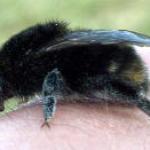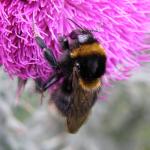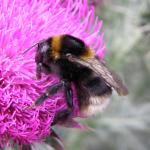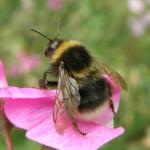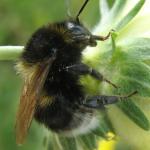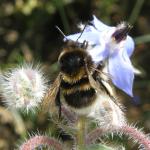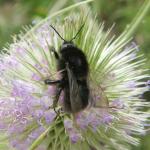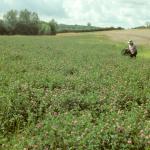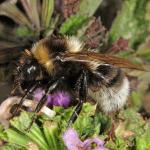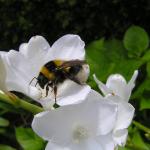Apis Perniger HARRIS 1776; Bombus villarricaensis ASPERENDE BOER 1992; Bombus ibericus PITTIONI 1938
Follows P. Williams: http://www.nhm.ac.uk/research-curation/research/projects/bombus/mg.html#ruderatus
A large bumblebee with a very long tongue, which is often held outstretched as the bee approaches a flower. It is one of the three species found visiting very deep blooms such as foxglove (Digitalis purpurea) and honeysuckle (Lonicera periclymenum)(the others being B. pascuorum and B. hortorum). Separating B. ruderatus and its close relative B. hortorum is very difficult, resulting in many problems in establishing the range of the latter species. There is considerable variability in the extent and brightness of the colour bands and the tail colour. All-black (including tail) specimens are most likely to be this species (named as variety harrisellus). (See BWARS Newsletter Aut. 2004). The situation becomes even more complex in mainland Europe, with at least one further, closely related, species present.
England, north to Northumberland. Due to considerable difficulties in confirmation of many of the records shown in the IBRA Atlas of Bumblebees (Anon 1980) the current map does not include records where a specimen has not been re-examined. However, there can be little doubt that it was formerly much more widespread than it is at present, although always much more southerly than B. hortorum. Found throughout central and southern Europe, but not including the Iberian peninsula. Here it is also much more southerly than B. hortorum in its distribution and is considered to be in major decline.
Accorded Notable B status by Falk (1991), (now known as Nationally Scarce (Nb)), this species is included in the UK Biodiversity Action Plan as a Priority Species.
Modern populations appear to have become centred on extensive river-valley systems in southern and central England, where it forages at plants such as comfrey (Symphytum spp.), yellow iris (Iris pseudacorus) and marsh woundwort (Stachys palustris). However, it has recently shown a great liking for the legume-dominated ‘Pollen and Nectar Margins’ being promoted as part of Agri-environment programmes. Following the establishment of these mixtures it has re-appeared in a number of localities.
The species is eusocial with queens emerging from hibernation from April to June; workers are present from May, and males and new females from July to October.The colony cycle of this species is slightly later than that of is congener B. hortorum.
Probably similar to that of B. hortorum.The nest size is reported to be large, with over 150 workers (Sladen 1912), but von Hagens (1994) gives 50-100 workers.
As well as the plants listed above, it will also visit very deep-tubed flowers such as foxglove (Digitalis purpurea) and honeysuckle (Lonicera periclymenum).
It is very likely that the cuckoo bumblebee Bombus barbutellus parasitises this species.
Profile written:
Proofed: February 2012


